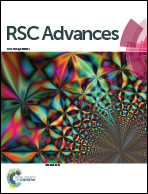Phenothiazine based sensor for naked-eye detection and bioimaging of Hg(ii) and F− ions†
Abstract
The design and development of new phenothiazine-based fluorescent probes, which display a selective fluorescence response to mercury and fluoride ions, were described. The probe is the first example that facilitates the detection of Hg2+ at nanomolar concentrations. The sensitivity of probe P-1 to Hg2+ and F− was demonstrated in living cells, and cell toxicity assays revealed that probe P-1 can be used for selective imaging of Hg2+ and F− in living cells. Moreover, the simple probe design presented here may contribute to the development of more efficient and more useful dual-mode probes.


 Please wait while we load your content...
Please wait while we load your content...